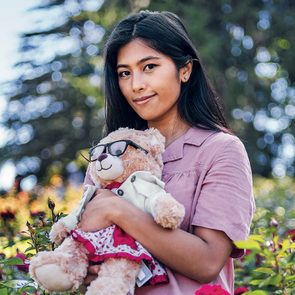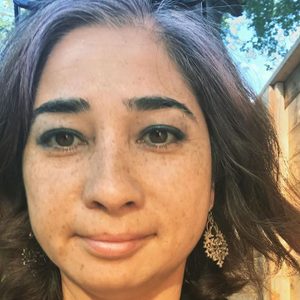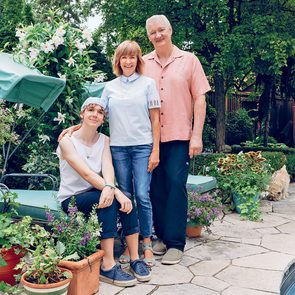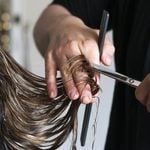My Curly Hair Once Made Me Feel Like an Outsider. Here’s How I Came to Embrace It
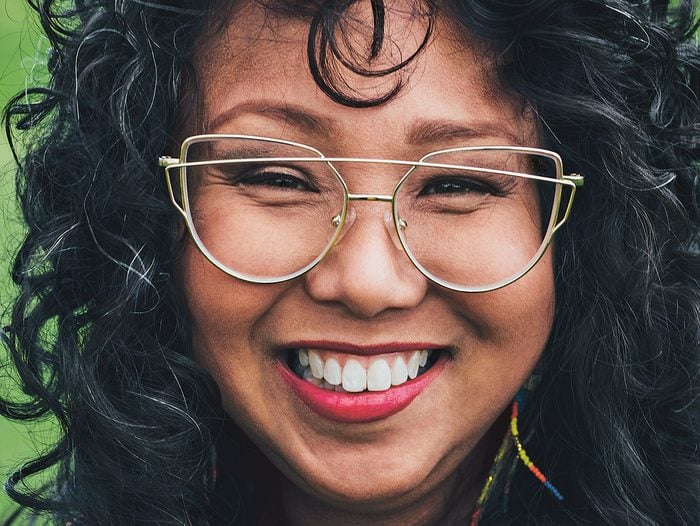
For most of my life, I was a curly lone wolf. Then, two years ago, I saw her.
The hairdresser told me I looked like Liza Minnelli. It was 1982 and I was nine. It wasn’t cool at my school, in the Don Mills neighbourhood of Toronto, to look like Liza Minnelli. It definitely wasn’t going to get me invited to sleepovers and parties. And besides, I didn’t even look like her. My skin was too brown and my hair didn’t fall down and stay close to my head. Instead, it stuck up everywhere, and there was so much of it.
“Comb your buhok,” my grandparents would always say. “How come you don’t comb it?”
But I did comb my hair! It just didn’t stay.
I know it’s only hair, but it kept me outside of my culture. I saw how I was different from other Filipinos. Their hair was straighter. Their skin was lighter.
My immigrant paternal grandparents, who raised me until I was 12, were deeply rooted in Filipino culture. My grandfather had formed a small community of Filipino Second World War veterans; though we lived in a mostly white neighbourhood, all their friends were Filipino. Because my childhood was filled with Filipino celebrations and events, I expected the community would be my default home in Toronto, my place of grounding.
Instead, it was like I was a visitor. Other Filipinos were always questioning my being there, like I wasn’t Filipino enough to be part of their crew. I felt like a failure for not being the person I was supposed to be—at least in their eyes.
Filipinos I had just met would always ask me things like:
“Are you full Filipina?”
“What’s your last name?”
“Mukha kang Pilipino, pero…” You look Filipino, but…
But…my hair. This questioning was constant. It happened so often the encounters blurred.
By my early teens, I was tired of floating alone and decided to land on the fringes. My circle of friends became more racially diverse, mostly made up of kids who, like me, felt like outsiders in their own communities. I also said goodbye to my inadvisable method of hair-straightening: on an ironing board, with a piping hot iron. So I decided to rebel with my hair, wearing it as big as I could.
For the next 30 years of my life, I was a curly lone wolf. On some occasions, though, my unease got the best of me—I straightened my hair for Christmas parties and my own wedding, thinking my curls were beneath such significant moments. I gritted my teeth when I received backhanded compliments from my aunts. The worst was, “Finally, you look decent!”
Then, two years ago, I saw her.
By that time I was 45. It was a night in April. The woman in question was sitting at the bar during a comedy show in Toronto. I recognized her lidded, almond-shaped eyes, her short-bridged nose and the brown of her skin as features like my own. Her hair, however, was long, curly and very much unlike other Filipinos. For the first time in my life, I saw a reflection of myself.
I thought, “Is she another one?”
After the show, I sat at the bar with a friend. Guess who sat beside me? Curly, ethnicity-yet-to-be-confirmed girl! She had barely landed on her seat when I pounced.
“Excuse me, what’s your background?” I asked, holding my breath. In my excitement, I didn’t even bother asking her name.
“I’m Filipina,” she said.
“Yes!” I yelled, then gave her a high five. But there was one more crucial question, and I knew my heart would break if it was the wrong answer.
“Are those your natural curls?” Again, I held my breath.
“Yes,” she said, smiling.
“Cool,” I said casually. But in my mind, I was running wildly around the bar, ripping off my clothes and pumping my fist in the air.
Then she told me about a Facebook group for curly Filipinas. My jaw went slack. There are more of us? Of me? I don’t have to be a lone wolf anymore. My unruly hair and my heritage will finally align.
I’d never been so excited to join a Facebook group. I went home, opened my laptop and found it. I was surprised by how large it was: thousands of members from around the world, mostly residing in the Philippines. I saw post after post of Filipinas sharing haircare tips, words of encouragement and personal stories about feeling less than pretty, less than Filipina.
Immediately, I posted “I love this group” and uploaded a photo of my curliest look. The replies were all positive. “Beautiful curls!” “You look lovely!” “Love your hair!” For the first time, these words weren’t condescending. Now they felt like a welcome-home hug: accepting, genuine and ready to let me in.
My hair required no disclaimer in this space—I had been disconnected from my Filipino community for so many years and this, finally, was my homecoming. I wrote one more post after a few days of poring over the group’s pages. “I always deliberately wear my hair curly and I let everyone know I am Filipina … I do this because I am proud of my heritage and I am proud of my hair.” I used to say this as an act of rebellion. Now, I mean it in a way I never did before.
I don’t ever intend to leave this group. I’m content knowing that we curly Filipinas, with our life stories and, yes, selfies, have finally found a space where we can fully exist.
For my last job interview, I kept my hair curly. It was the first time I’d done so.
People still compliment my curls.
“Did you do something to your hair? Is that natural?” they ask.
“This is natural. It’s all me,” I reply.
“You’re so lucky.”
Yes, I am.
Next, find out how Asian Canadians are fighting racism during the pandemic.
